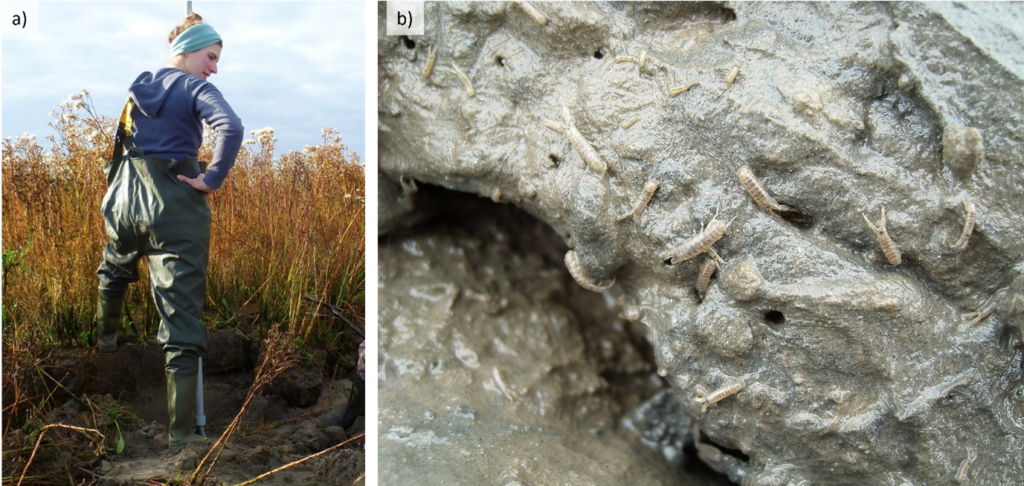Dr. Muriel Brückner is a researcher in the Cryosphere, Coastal and River Dynamics group at the University of Exeter. Here she gives us a glimpse of the fascinating questions that have taken her around the world from Germany to Norway, the Netherlands, New Zealand and more!
Ecosystem engineering by tiny shrimp and worm can cause large coastal change
I like the beach. I like the roughness of the waves, the sun, the wind on my face, and I like to swim in the water and afterwards have some ice cream. I guess you may share this feeling and have been to the beach for a walk or to build some sandcastles. Maybe you have noticed that the beach does not always look the same; every year it is a bit larger or smaller, new rocks are brought to the shore, there is algae or plants growing and you can collect new shells and maybe a small fossil that pops up in the sand. To understand how our beaches change is important because we live close to them and we want to be able to keep using them. This is why I decided to become an environmental engineer and study what causes these changes and how we can predict them.
How our coasts look depends on many different factors. First, the power of the tides and the waves that mobilize the sands and muds cause erosion and transport them over large distances. The sand will then deposit on another beach somewhere further away which over several years can change the shape and size of the entire coast. The pattern of this erosion and deposition depends on the direction and strength of the wind and the waves, the tide, the weather, etc.. But also the characteristics of the coast are important; do we find sand, mud or pebbles, how shallow is the water, are there many ships and buildings, and do algae, mussels or plants live in or close to the water. Especially the effects of living organisms are fascinating to me and one of the reasons why I started studying coastal biogeomorphology, the study on how organisms and the physical environment interact.
We know that plants can have a large effect on the erosion of sand and mud because they reduce the strength of waves and tides with their stems and leaves. Their roots grab onto the sand and prevent it from being transported away. This natural effect of the plants is called ecosystem engineering because they can indirectly engineer their habitat and can reduce the transport of sand away from the beach. Obviously, this is exciting and the reason why more and more scientists look into the use of plants as coastal protection. Those ‘nature-based solutions’ are thought to be more sustainable than traditional coastal protection only, such as building dikes or bringing in sand from elsewhere to fill in the beaches after they eroded. In addition to plants, also mussel and oyster reefs can be used to protect against erosion and what organisms are most suitable depends on the type of the beach and the climate.
During my journey as a scientist, I lived in several different countries around the world and learned about many more organisms that can change their environment through ecosystem engineering. Even tiny and almost unseen organisms that inhabit the sands and mudflats along the beaches have their own way of moving around or protecting the sand. When you walk across the beaches after the tide left the shore you might have noticed some tiny holes or sand mounds that were built by worms and shrimp living in the mud. Those small holes seem innocent, but when in large numbers they may have big effects because they loosen up the sand over a large area. After all, the ocean is big and gives habitat to many, many worms and shrimp. To know how those organisms can increase sand erosion and how they will affect our coasts, I developed a computer model that incorporates their ecosystem engineering in the transport of sand and mud. This allowed me to show that they can change entire coastlines because they indeed increase transport of sand and mud. This is quite an unexpected result because we thought that those organisms are too small to have an effect over large distances. Knowing that even a tiny shrimp contributes to how our coasts look today got me and other scientists excited to now look into other tiny organisms that live in the sand to understand more about future coastal change. And perhaps we can also incorporate those one day as nature-based solutions.

Figure 1: a) Measuring ecosystem engineering effects of a Dutch salt marsh in the Western Scheldt Estuary. B) The mud shrimp (Corophium volutator) and its burrows in its habitat in the Wadden Sea (By C. Löser – Own work, CC BY 3.0 de, https://commons.wikimedia.org/w/index.php?curid=11068940)
